April 15th of each year is the federal tax day in the United States. It is the due date for filing federal and state income tax forms. When the federal tax day is at hand, professionals and businesses prepare their tax forms to report their income to the Internal Revenue Service (IRS), the US federal tax agency.

Whether you are a professional who files income tax forms yearly or a first-time filer, aside from the tax forms you need to submit to the IRS, it is wise to be well aware of your tax obligations and the destination of your taxes.
Taxes are mandatory fees a government levies on individuals and corporations to finance nationwide activities that benefit all citizens. From the salaries of people who work in the government and the budgets of different departments of the government to public health programs and infrastructures, the money you pay in taxes contributes to the building of a nation.
Every citizen has a duty or obligation to pay all applicable taxes. In the US, the government classifies taxes into three brackets: taxes on what you own, taxes on what you buy, and taxes on what you earn. In this article, we will focus on the common tax forms to use for the taxes on what you earn.
Table of Contents
Taxes on Income and Earnings
The government levies income taxes on personal and business revenue. The federal tax system is progressive — high-income earners pay a higher tax rate than low-income earners. Such a tax system lessens the burden on low-wage taxpayers.
Individual Income Tax
The largest source of tax revenue in the US, an individual income tax or personal income tax is a type of tax the government imposes on salaries, wages, investment, and other forms of income an individual or household earns. It applies to full-time employees and self-employed professionals.
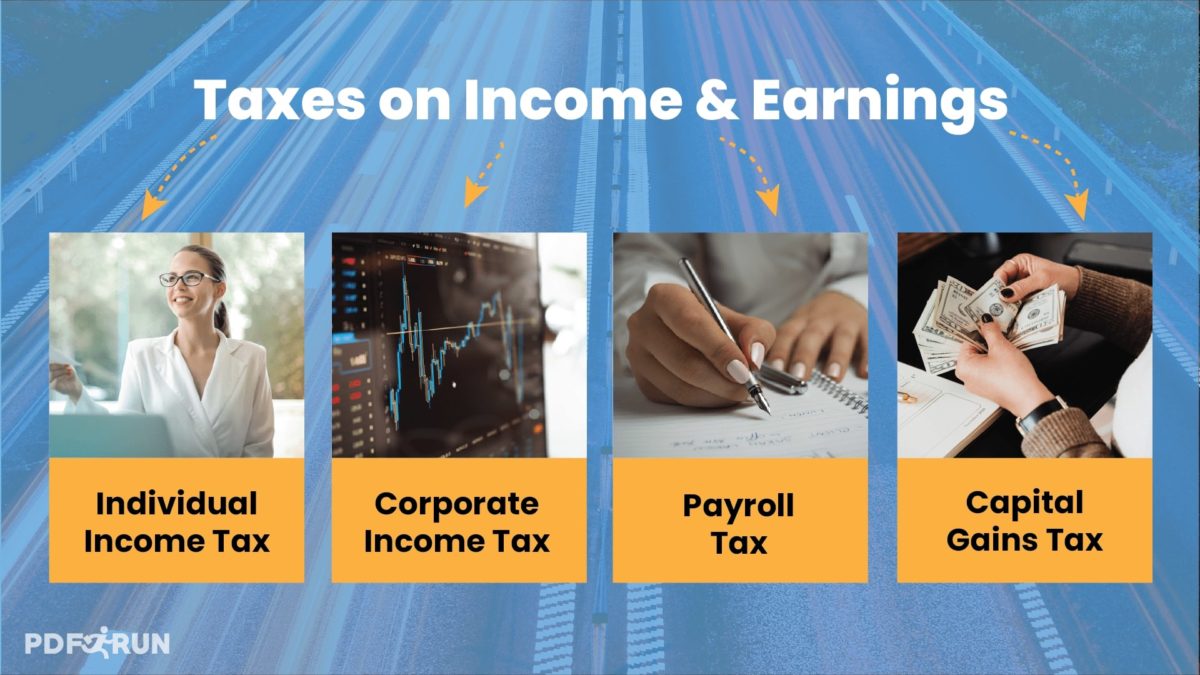
Corporate Income Tax
A corporate tax is a type of tax the government imposes on the profits of a business. It applies to all corporations incorporated in the country, corporations doing business in the country, foreign corporations that have a permanent establishment in the country, and corporations that are residents in the country for tax purposes.
Payroll Tax
A payroll tax is a type of tax employers deduct from the payroll of their employees to abide by the Federal Insurance Contributions Act (FICA). The government uses payroll taxes to fund Social Security and Medicare.
Capital Gains Tax
A capital gains tax is a type of tax an individual pays for the profit made from the sale of an asset. When an individual realizes a capital gain due to selling an asset that has increased in value, such as real estate, stocks, art, and jewelry, he must pay tax on the profit earned.
US Tax Forms
Tax forms are official documents taxpayers and tax-exempt organizations use to report financial information to the IRS.
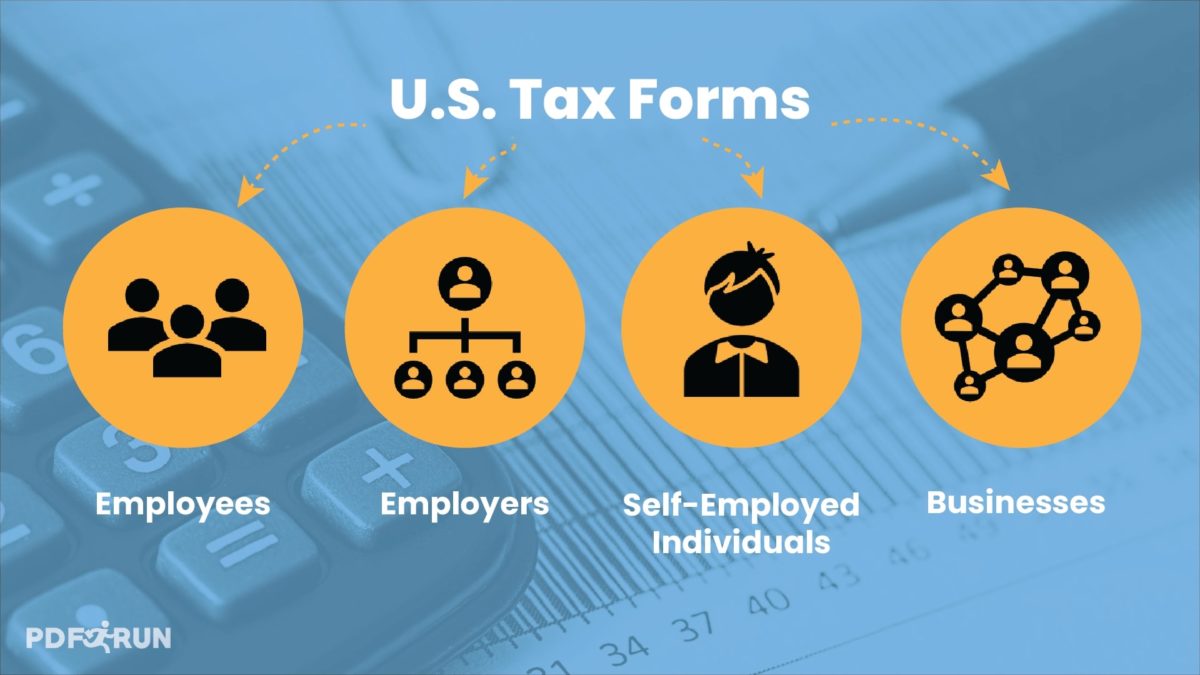
There are different tax forms for different classifications of taxpayers. Every tax form serves a distinct purpose.
Tax Forms for Employees
An employee is a professional who is hired by a business — referred to as the employer — who receives an hourly pay or annual salary to fill a job position and fulfill specific duties. Freelancers and independent contractors are NOT employees.
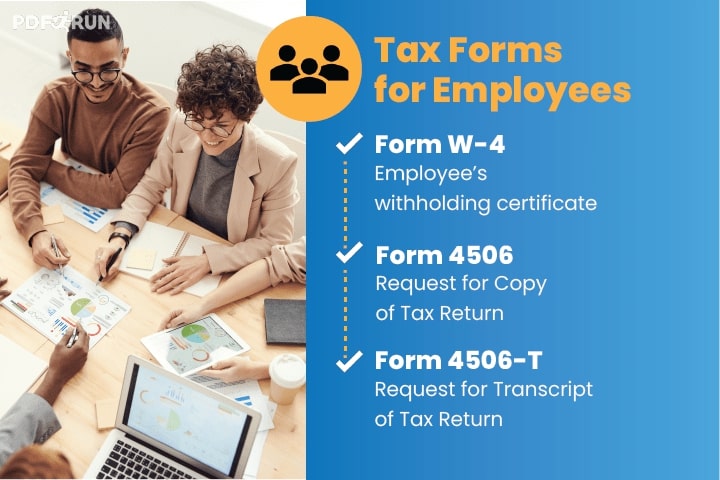
Form W-4, Employee’s Withholding Certificate
Employees complete Form W-4 to inform their employers of the amount of money to withhold from their paycheck. When you start a new job, you need to submit Form W-4 in the first month of your employment. You can also use it when there are significant changes in your income and financial status.
While Form W-4 allows you to determine your standard deduction based on your wage and the number of allowances you qualify for, you can also use it to declare yourself exempt from withholding. When you declare yourself as tax-exempt, your employer would not withhold any amount from your income.
Determine just the right amount of tax your employer should withhold from your paycheck. If you overpay, you will get a refund at the end of the year; however, it will be as if you have given the federal government an interest-free loan. If you withhold less than the correct amount, you will receive a tax bill and possibly a penalty for underpayment.
Submission: Submit Form W-4 to the payroll or human resources department of your employer and not to the IRS.
Form 4506, Request for Copy of Tax Return
Taxpayers use Form 4506 to request exact copies of previously filed tax returns and tax information from the IRS. There are several reasons to request copies of your tax return. You may use copies to complete a current-year tax return, amend a prior-year tax return, file a claim for refund or abatement, defend an IRS audit, or apply for government benefits, among other reasons.
In general, copies are available for returns you filed in the current year and the past seven years. Some returns may be available for a longer time. Each return request has a $50 fee.
Note: All taxpayers can use Form 4506.
Form 4506-T, Request for Transcript of Tax Return
While you should use Form 4506 to request a copy of your original return, Form 4506-T is for requesting a transcript of your return.
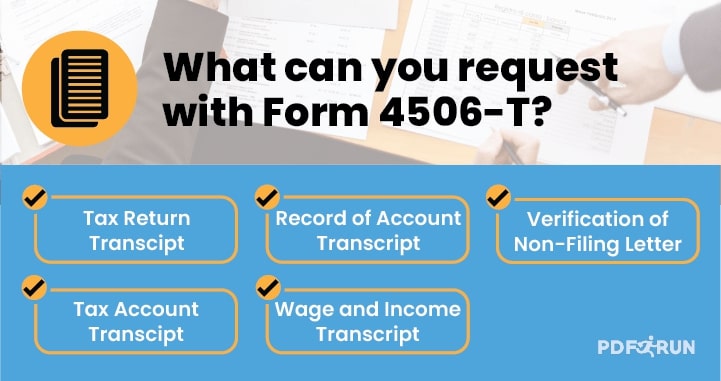
The transcripts you can request using Form 4506-T are:
- Tax Return Transcript
- Tax Account Transcript
- Record of Account Transcript
- Wage and Income Transcript
- Verification of Non-Filing Letter
Requesting a transcript of previously filed tax returns is free of charge.
Submission: To know where to mail or fax Form 4506-T based on the state where you filed your return, refer to the information on the IRS website.
Note: All taxpayers can use Form 4506-T.
Tax Forms for Employers
Employers have the responsibility of withholding taxes from the wages of their employees. They pay directly to the government and report withholding taxes using tax forms.
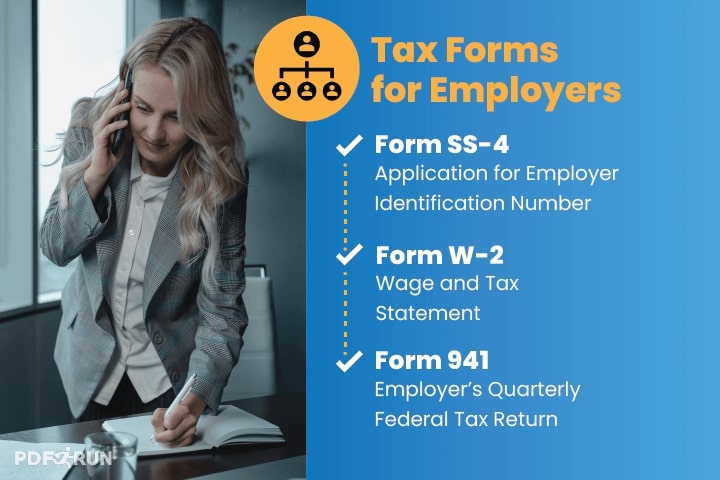
Form SS-4, Application for Employer Identification Number
If you have a business, you can use Form SS-4 to apply for a tax identification or Employer ID Number (EIN). The IRS assigns an EIN to employers, corporations, partnerships, sole proprietorships, trusts, estates, agencies, churches, and qualified individuals, among others, for tax filing and reporting purposes.
An EIN is a unique nine-digit identification number combination. Employers who have an EIN can use it for legal purposes, to open a business bank account, and to apply for loans. There is no fee to apply for an EIN.
Submission: To know where to mail or fax Form SS-4, refer to the information on the IRS website.
Form W-2, Wage and Tax Statement
The IRS mandates employers to report the wage and salary information of their employees using Form W-2 at the end of the year. Form W-2 shows the wages and the amount of taxes withheld from the paycheck of each employee.
Form W-2 consists of six copies. As an employer, you will keep a copy, forward two copies to the government, and give three copies to the employee involved.
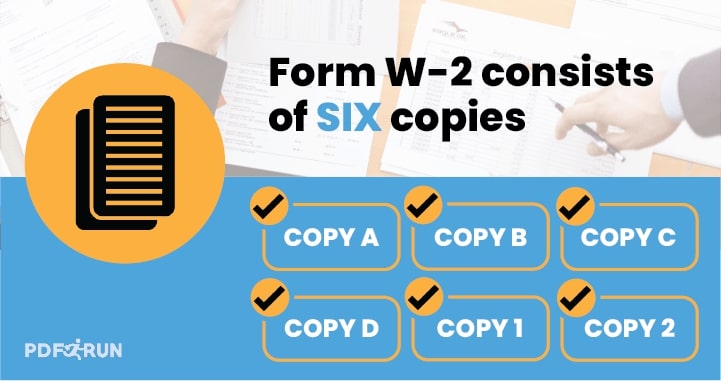
Here are the instructions for each copy of Form W-2:
- Copy A — You submit Copy A of Form W-2 to the Social Security Administration (SSA), together with Form W-3, Transmittal of Wage and Tax Statements. The SSA uses Copy A of Form W-2 to calculate and determine the Social Security benefits an employee is entitled to, based on his or her Federal Insurance Contributions Act (FICA) taxes.
- Copy B — You give Copy B of Form W-2 to the employee involved. The employee uses Copy B of Form W-2 to report his or her federal income taxes.
- Copy C — You give Copy C of Form W-2 to the employee involved for his or her record.
- Copy D — You keep Copy D of Form W-2 for the company’s records.
- Copy 1 — You submit Copy 1 of Form W-2 to the appropriate state, city, or local tax department, if applicable.
- Copy 2 — You give Copy 2 of Form W-2 to the employee involved. The employee submits it to the appropriate state, city, or local tax department, if applicable.
Submission: If you are filing more than 250 W-2 forms, the SSA requires you to e-file them via the SSA’s Business Service Online website.
If you are filing paper forms, mail all Form W-2 to:
Social Security Administration
Direct Operations Center
Wilkes-Barre, PA 18769-0001
Form 941, Employer’s Quarterly Federal Tax Return
Employers use Form 941 to report income taxes, Social Security taxes, and Medicare taxes withheld from the paychecks of their employees.
The following are the due dates for filing Form 941:
| Quarter | Due Date |
| First Quarter (January, February, March) | March 31 |
| Second Quarter (April, May, June) | June 31 |
| Third Quarter (July, August, September) | September 30 |
| Fourth Quarter (October, November, December) | December 30 |
When a due date falls on a holiday or weekend, the next business day becomes the new due date.
Submission: To know where to mail Form 941, refer to the information on the IRS website.
Tax Forms for Self-Employed Individuals
Unlike employees, self-employed professionals are not subject to tax withholding; thus, they are solely responsible for paying and filing self-employment taxes.
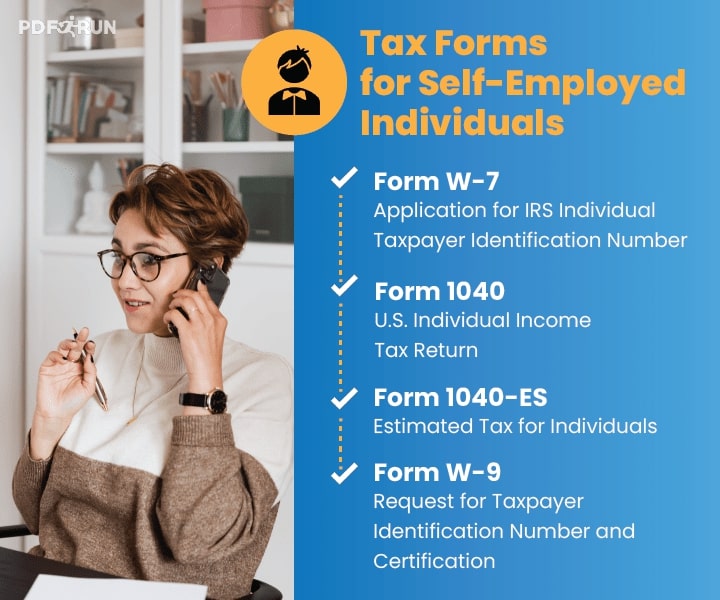
The current self-employment tax rate is 15.3 percent. The rate is the sum of a 12.4 percent Social Security tax and a 2.9 percent Medicare tax on net earnings.
Form W-7, Application for IRS Individual Taxpayer Identification Number
You can use Form W-7 to apply for an IRS Individual Taxpayer Identification Number (ITIN) or renew your expiring or expired ITIN.
An ITIN is a unique nine-digit identification number combination that the IRS issues to non-citizens who are not eligible to receive a Social Security number (SSN) but need to file a federal tax return.
Submission: Mail your completed Form W-7 and the required supporting documents to:
Internal Revenue Service
ITIN Operation
P.O. Box 149342
Austin, TX 78714-9342
Form 1040, U.S. Individual Income Tax Return
Individual taxpayers use Form 1040 to file their annual income tax returns. No matter your tax status you may use Form 1040 to calculate and report your gross income and tax liability after tax credits and deductions. It determines the amount of tax you owe or the refund you will receive.
Based on the latest conditions set by the IRS, individual taxpayers must file Form 1040 if:
| Your filing status is … | At the end of 2020 you were … | And your gross income was at least … |
| Single | Under 65
65 or older |
$12,400
$14,050 |
| Married filing jointly | Under 65 (both spouses)
65 or older (one spouse) 65 or older (both spouses) |
$24,800
$26,100 $27,400 |
| Married filing separately | Any age | $5 |
| Head of household | Under 65
65 or older |
$18,650
$20,300 |
| Qualifying widow(er) | Under 65
65 or older |
$24,800
$26,100 |
If you are self-employed — a freelancer or independent contractor and have net earnings of at least $400, you have to file Form 1040 even if you have not met the gross income thresholds shown above.
The address to where you should file your physical Form 1040 depends on where you live. The Instructions section of Form 1040 shows the addresses.
Submission: If you are filing online and your Adjusted Gross Income (AGI) is $66,000 or less, you can use IRS Free File. Otherwise, you may refer to the information on the IRS website to know where to file Form 1040.
Form 1040-ES, Estimated Tax for Individuals
Self-employed professionals, such as independent contractors and freelancers, do not have tax deductions from their pay. If you are self-employed, you can use Form 1040-ES to calculate the amount of taxes you owe. Your current income will affect the calculation. You can refer to your federal tax return from last year and look at your taxable income, tax paid, credits, and deductions and compare them to your current numbers.
In general, if you suppose you need to pay quarterly taxes and expect to owe more than $1,000 in taxes for the year, you should use Form 1040-ES.
The following are the due dates for paying quarterly estimated taxes:
| Payment Period | Due Date |
| January 1 — March 31 | April 15 |
| April 1 — May 31 | June 15 |
| June 1 — August 31 | September 15 |
| September 1 — December 31 | January 15 of the following year |
Submission: To know where to mail Form 1040-ES, refer to the information on the IRS website.
Form W-9, Request for Taxpayer Identification Number and Certification
Form W-9 is for self-employed individuals — independent contractors, consultants, or freelancers. A client or business may request you to fill it out and will use the information you will provide to complete Form 1099-NEC. Its main purpose is to get your correct taxpayer identification.
A client or business will not require you to complete Form W-9 if you receive $600 or less non-employee compensation in a single year.
In some situations, institutions may ask you to fill out Form W-9, including:
- certain real estate transactions;
- payment of mortgage interest;
- payment of student loan interest;
- cancellation of debt; or
- earning interest from a bank.
Submission: Return Form W-9 to the person or company requesting it.
Tax Forms for Businesses
The structure of a business determines the types of taxes to pay or t and tax forms to use.
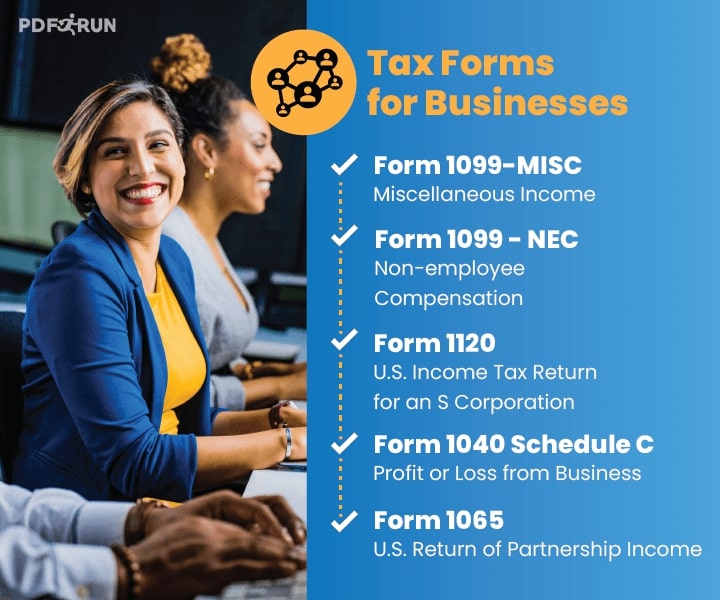
Form 1099-MISC, Miscellaneous Income & Form 1099-NEC, Non-employee Compensation
In the past, if your business paid more than $600 non-employee compensation to an independent contractor, you used Form 1099-MISC. Now, the IRS introduced Form 1099-NEC for all non-employee compensation. You will no longer report non-employee compensation using Form 1099-MISC.
While the IRS now requires Form 1099-NEC for non-employee compensation, Form 1099-MISC is still applicable. File Form 1099-MISC for each person to whom you have paid the following during the year:
- At least $10 in royalties or broker payments in lieu of dividends or tax-exempt interest.
- At least $600 in:
- rent;
- prizes and awards;
- other income payments not reportable in one of the items on the form;
- the cash paid from a notional principal contract to an individual, partnership, or estate;
- any fishing boat proceeds;
- medical and healthcare payments;
- crop insurance proceeds;
- payments to an attorney;
- section 409A deferrals; or
- non-qualified deferred compensation.
File Form 1099-NEC for non-employee compensation if all of the following conditions are applicable:
- You paid someone who is not your employee.
- You paid for services in the course of your trade or business.
- You paid an individual, partnership, estate, or corporation.
- Your payments to the payee for the year were at least $600.
Both Form 1099-MISC and Form 1099-NEC consist of six copies.
- Copy A — You submit Copy A of Form 1099-MISC or Copy A of Form 1099-NEC to the IRS.
- Copy B — You give Copy B of Form 1099-MISC or Copy B of Form 1099-NEC to the independent contractor for his or her record.
- Copy C — You keep Copy C of Form 1099-MISC or Copy C of Form 1099-NEC for your records.
- Copy 1 — You submit Copy 1 of Form 1099-MISC or Copy 1 of Form 1099-NEC to the state income tax department of the independent contractor.
- Copy 2 — You give Copy 2 of Form 1099-MISC or Copy 2 of Form 1099-NEC to the independent contractor for him or her to submit to his or her state income tax department when required.
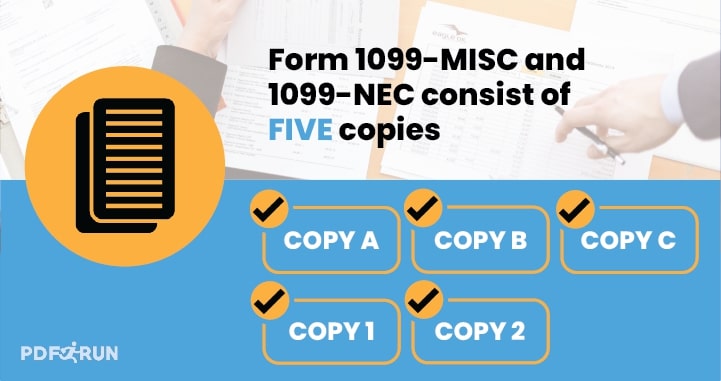
Submission: Furnish Form 1099-NEC to the independent contractor and file with the IRS no later than January 31 of the following year. If the date does not fall on a business day, the next business day becomes the due date.
For 2021, you must furnish Form 1099-MISC to the independent contractor by February 1 and file with the IRS on March 31.
Form 1120-S, U.S. Income Tax Return for an S Corporation
To become an S corporation, the corporation must submit Form 2553, Election by a Small Business Corporation, to the IRS and the IRS should accept the election. Businesses registered as S corporations use Form 1120-S to report income, losses, and dividends of S corporation shareholders. The form will help determine tax payments or refunds due to shareholders on their personal income tax returns.
In general, you must file Form 1120-S on March 15, the 15th day of the third month after the end of a tax year. If the due date falls on a holiday or weekend, the next business day becomes the new due date.
Submission: To know where to mail Form 1120-S, refer to the information on the IRS website.
Schedule C (Form 1040), Profit or Loss from Business (Sole Proprietorship)
If you are a sole proprietor, the profits and losses of your business pass through to your personal income tax. As a self-employed individual, you use Form 1040, U.S. Individual Income Tax Return, to report your personal income tax.
Use Schedule C (Form 1040) to inform the IRS of the profits and losses of your business in the last year. The federal tax agency will use the information in Schedule C (Form 1040) to calculate the taxable profit you made.
Submission: Attach Schedule C (Form 1040) to your Form 1040. If you are filing online and your Adjusted Gross Income (AGI) is $66,000 or less, you can use IRS Free File. Otherwise, you may refer to the information on the IRS website to know where to file Form 1040 and Schedule C (Form 1040).
Form 1065, U.S. Return of Partnership Income
Form 1065 is an information return that declares the profits, losses, credits, and deductions of a business partnership to the IRS and provides a financial status overview. However, it does not calculate and determine the amount of taxes partners owe. The tax liabilities of partners pass through to their personal income tax.
Since partners are not employees, each of them has to complete Schedule K-1 to report a share of income, credits, and deductions.
Submission: To know where to mail Form 1065, refer to the information on the IRS website.
The primary purpose of tax forms is to report financial data, from individual income and expenses to business profits and losses. There are almost a thousand IRS tax forms in the US that taxpayers need to file with the state and local government. Therefore, it is your responsibility as a taxpayer to familiarize yourself with the right tax forms to use.
Are you looking for tax forms? We maintain an online library of legal and business documents.